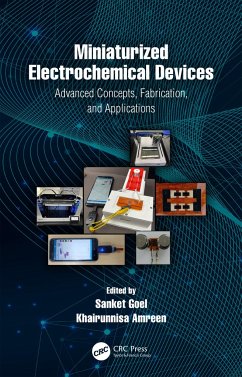Evidently, electrochemical sensing has revolutionized the electroanalytical detections in the world. Since the 19th century, a huge amount of growth has been visible on various fronts, such as biosensors, energy devices, semiconductor devices, communication, embedded systems, sensors etc. However, the major research gap lies in the fact that most of the reported literatures are bulk systems; hence there are limitations for practical applications.
Research in these domains has been carried out by both academia and industry, whereby academics is the backbone whose intellectual outputs have been widely adopted by the industry and implemented for consumers at large. In order to impart portability to the electrochemical sensors for point-of-care application, the collaboration of electrochemistry, micro uidics, electronics and communication as an interdisciplinary forum is crucial. The miniaturization, automation, IoT enabling and integration are the requirements forbuilding the mentioned research gap. The conversion of electrochemical sensing theoretical concepts to practical applications in real time via miniaturization and integration of micro uidics will enhance this domain. In this context, of lately, several research groups have developed miniaturized microdevices as electrochemical-sensing platforms. This has led to a demand of offering a reference book as a guideline for the PhD programs in electrochemistry, MEMS, electronics and communication. Undoubtedly, this will have a huge impact for R&D in industries, public-funded research institutes and academic institutions.
The book will provide a single forum to understand the current research trends and future perspectives of various electrochemical sensors and their integration in micro uidic devices, automation and point-of-care testing. For students, the book will become a motivation for them to explore these areas for their career standpoints. For the professionals, the book will become a thought-provoking stage to manoeuvre the next-generation devices/processes for commercialization.
Research in these domains has been carried out by both academia and industry, whereby academics is the backbone whose intellectual outputs have been widely adopted by the industry and implemented for consumers at large. In order to impart portability to the electrochemical sensors for point-of-care application, the collaboration of electrochemistry, micro uidics, electronics and communication as an interdisciplinary forum is crucial. The miniaturization, automation, IoT enabling and integration are the requirements forbuilding the mentioned research gap. The conversion of electrochemical sensing theoretical concepts to practical applications in real time via miniaturization and integration of micro uidics will enhance this domain. In this context, of lately, several research groups have developed miniaturized microdevices as electrochemical-sensing platforms. This has led to a demand of offering a reference book as a guideline for the PhD programs in electrochemistry, MEMS, electronics and communication. Undoubtedly, this will have a huge impact for R&D in industries, public-funded research institutes and academic institutions.
The book will provide a single forum to understand the current research trends and future perspectives of various electrochemical sensors and their integration in micro uidic devices, automation and point-of-care testing. For students, the book will become a motivation for them to explore these areas for their career standpoints. For the professionals, the book will become a thought-provoking stage to manoeuvre the next-generation devices/processes for commercialization.








